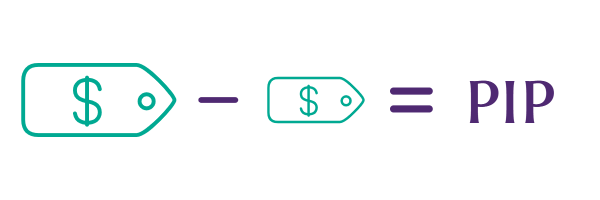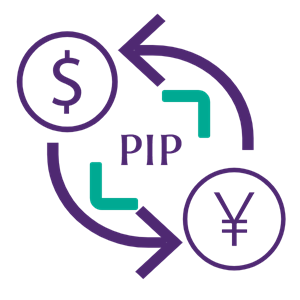What does pip stand for in Forex?
Forex trading is based on the price changes of the currency pairs. And the most popular method of calculating those changes is via pips. The reason for that is instead of the actual value in a currency, pips represent the changes in units which then can be easily transformed into different currency values.
So, what is a pip anyway? A pip measures the price change of the currency pair. As for the pip meaning in Forex, the term is an abbreviation of “Percentage in Point” and is considered the smallest change an exchange rate can make on the market.

For example, if somebody bought the USD/CNY (US dollar/Chinese yuan) currency pair at a price of 1.2456 (theoretically) and then sold it at the selling price of 1.2455, the difference between the prices will be one pip.
Both traders and service providers (brokers) are actively using pips to calculate their payouts. But one thing to keep in mind is that there are two main ways of determining pips for currency pairs:
- Pips for the most pairs (0.0001)
- Pips for the JPY pairs (0.01)
there are also
- Nano pips for the most pairs (0.00001)
- Nano pips for the JPY pairs (0.001)
Pips for the majority of pairs
The more stable currency pairs such as EUR/USD or USD/CNY use a different method of how to calculate pips . For them, a pip represents the fourth place after the decimal point - 0.0001. In the above-mentioned example, we used this method: the fourth number from the decimal point in 1.2456 is 6, therefore, the change at that position of 0.0001 generated one pip. If the selling price was 1.2454, we would get 2 pips (6-4=2).

The majority of currency pairs use this calculation method. So, let’s imagine that a trader buys a USD/CNY pair at the current price of 6.9876. Then, he/she waits for a while until the price increases a little bit. One can expect that because prices on
currency markets change all the time.
Now, let’s assume that the USD/CNY price increased to 6.9879. That is usually the time when traders tend to sell their pairs on the market. So, the difference between the two prices is 0.0003. Therefore, a trader has generated three pips as a result of the trade.
Pips for the JPY pairs
Now, even though almost all currency pairs use the above-mentioned method, there is one group of currency pairs that uses a slightly different method. This method is used for calculating pips Forex currency pairs that include the Japanese yen. For example, the USD/JPY pair uses the second number from the decimal point, instead of the fourth one, to determine pips.

For example, the exchange rate on the USD/JPY is currently at 103.56, meaning that a person can buy 103.56 Japanese yens for 1 US dollar. So, just like above, let’s imagine that a trader buys this pair at this current price.
Now, let’s assume the price goes up at 103.59 and that same trader decides to sell the pair. The difference between 103.56 and 103.59 is 0.03, therefore, the trader will receive 3 pips.
Nano pips
Now, even though these two methods are the most popular in Forex, there is one more measurement method that is more accurate than the previous ones. It is called nano pip or “pipette.” According to the nano pip Forex definition, it represents the price change of the fifth number after the decimal point, instead of the fourth one.
For example, if the above-mentioned USD/CNY exchange rate was to increase from 6.9876 to 6.98794, the difference would be 0.00034 and a trader would get 34 nano pips. And for the Japanese yen pairs, nano pips are measured in the third place after the decimal. This method is important for reflecting the slightest changes in prices that could be easily missed otherwise.
Calculating the value of pips in Forex
Now that we know what pips in Forex are, as well as their variations, and how to measure them, let’s see how to actually calculate their value. As mentioned earlier, service providers usually calculate the values automatically, however, knowing how it is done is still useful.
The pip value is basically a price of one pip generated in a Forex trade. And it varies from one currency pair to another. That’s why it’s important to measure the pip value for different currencies.
So, to calculate the pip value, traders need to divide the number of pips (either by 0.0001 or 0.01 standards) by the current exchange rate of the currency pair, and then multiply that figure by the lot size (standard, mini, or micro). And the received number will be a value of one pip in the base currency (the second currency in a pair). But when a pair has the USD as a base currency, the pip value will always be $10.
First off, let’s assume that a trader opened a position for one lot (CNY100,000). So, if the USD/CNY currency pair has generated 2 pips, and the current exchange rate is 6.9876, the value of the pips will be calculated like this: (0.0002/6.9876)x100,000=2.86. So, the trader has received 2.86 US dollars from the trade.
Pips in CFDs
So, we have answered the question of “in Forex what is a pip?”: a pip is a measurement of the change in currency pair prices. However, they can also measure other assets. For example,
CFD (contract for difference) is one of the popular forms of trading which uses not the assets themselves, but the contracts about their price movements to conduct a trade.

For example, the two contractors make a deal that the price movement in the EUR/USD exchange rate will decide if a trader gets a payout or not. This way, there is no need to actually buy the currencies.
So, to calculate the size of the payout, the contractors still use pips. In CFD trading, like in Forex and other markets, a pip represents the smallest change in the asset price that can also influence the CFD. For example, if the contract has a EUR/USD pair as an underlying asset, one pip will be 0.0001 change in the price (or something different which the contractors agree upon). And since the base currency is USD, one pip will have $10 of value.